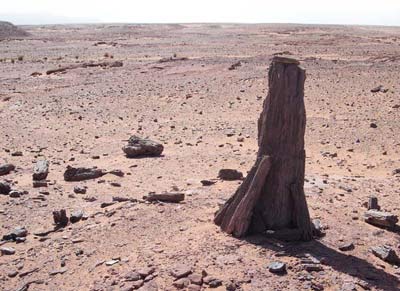begins his journey south from the Mediterranean coast,
first stopping at three oases along the way.//

Hüsnü Bey has left the coast at Sellum (number 7) and
gone south to Siwa Oasis. From there, he crosses west to
the Jaghbub Oasis and then further west to Jalo Oasis.
Since Hüsnü Bey is a Moslem, he was able to go to the Senussis but
he couldn't remain with them for long. After nine days, the Egyptian
traveler reached the Siwa oasis, one of the oldest and most famous in
the Libyan desert and the site of the ancient Ammon temple. Alexander
the Great is said to have visited Siwa, as well.
Siwa's water sources are plentiful so it is famous in the East for its
abundant dates and olive oil. There is a strange custom here, whereby
everyone, rich and poor, piles dates at a particular place and anyone
passing by can partake, on the condition that they don't put any of the
dates in their pockets or under their clothes!
After leaving Siwa, Hüsnü Bey took off his European clothes and
donned Bedouin garb. While en route to Jaghbub, he encountered
El Sayyid İdris es Senussi, the chief of the Senussis (and future King
of Libya), who gave Hüsnü Bey guidance and a letter of
recommendation for transit through the lands of the tribes further to
the south.
İdris of Libya click here for Wikipedia background.
Jaghbub, the center of Senussi education, has a medrese with 500-600
students who learn the tenets of the Senussi sect. Hüsnü Bey had to
remain at Jaghbub for five weeks. After long negotiations with the
tribal chiefs there, he bought two camels and headed for the Jalo oasis.

En route to Jalo, Hüsnü Bey encountered a petrified forest. He related
that "In very ancient times, the desert dwellers used the big parts of
the petrified trees as road markers. It goes without saying that even the
slightest breeze can move the sand in this vast area to cover the roads.
When a caravan passes by, rocks are placed in a pile to mark the way
for the next caravan. The area is so desolate, that a traveler is happy
to see the skeleton of a camel, or even a person, because it shows that
a caravan has passed this way before."
Here is an example of Hüsnü Bey's courage and cool-headedness
that everyone will be amazed to read:
"There was a sand storm that continued for eight days that had quite
an impact on our journey. The desert was calm but the wind speed
began to increase minute by minute. Gradually, the scene came to
resemble a plain with countless steam spouts,,with ever-larger grains
of sand whirling in the air and challenging one's courage.
Moving against the wind, the traveler must proceed ever-so-slowly,
lest he lose his way. However, if the wind blows from the side the
difficulty eases because the "kukulete" (hood) of the Bedouins' outfit
protects the face and eyes. One day this week, we had no choice but
to walk into the wind and that's when we understood how a sand
storm can destroy a caravan. We walked forward very deliberately
but stopping was not an option, because he who stops will quickly be
buried alive by the blowing sand. The camels are more used to the
torture of the sand storm bombardment and they press on, but when
it rains they collapse right away."
//END of PART II//

Hiç yorum yok:
Yorum Gönder